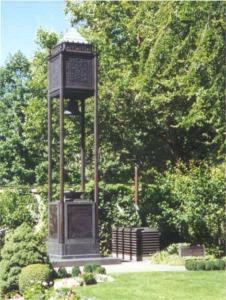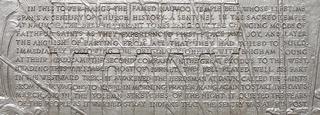
Salt Lake City, UT
Nauvoo Bell
GPS Coords: ?
The Nauvoo Bell, weighing over 1,500 pounds, was originally donated by the British Saints for the Nauvoo Temple and brought to the United States by Wilford Woodruff. When pressure from mobs forced the Saints to evacuate the city, the bell was left behind and placed in a local Protestant church. It was recovered by members of the Lamoreaux family before they left Nauvoo to head west.
"One stormy night the men gathered in secret and without horses pulled the wagon to the Church and lowered the Bell, pushed and pulled the wagon by hand to the edge of the Mississippi River and carefully concealed it in the water. Andrew Lamoreaux and his brother, David, were chosen to bring the Bell to Utah with their families, concealing the Bell in their wagon with their provisions."
On the journey to Salt Lake City the bell was used to "awaken the herdsmen at dawn, to signal morning prayer, to start the day’s march, and to sound during the night watches to let the Indians know that the sentry was at his post." Once in Salt Lake City the bell was used in several locations such as the first old bowery, Brigham Young's schoolhouse, a Church business building and the Bureau of Information on Temple Square. It didn't find it's present day location and permanent home until 1942 when the Relief Society placed it in a bell tower on Temple Square to celebrate their centennial.
Placing the bell on Temple Square fulfilled a 1862 prophecy by Brigham Young: "Right west of the temple we shall build a tower and put a bell on it.... This plan was shown to me in a vision when I first came onto the ground." (B. H. Roberts, A Comprehensive History of the Church, 5:136).

In 1961 President David O. McKay, presiding at a ceremony at KSL-TV, said: "In its own way, the Nauvoo bell is a symbol of religious freedom in our land. . . . When we hear, henceforth, the sound of the Nauvoo bell, let it remind us anew that our nation and our community owes its existence to our trust in God." ("As We See It," Church News, July 29, 1961).
Today the bell rings at the beginning of each hour. The ring of the bell on the hour has been featured for years on KSL radio as well to mark the "top of the hour". It is also interesting to note that the ringing of the Nauvoo Bell can be controlled by a panel on the Mormon Tabernacle organ. The bell is also rung on special occassions such as the recent memorial services held on September 14, 2001 for those who died in the terrorist attacks on the United States of America.
4 comments:
Here's a few caches (gps coords)around utah. Hope this is what you're looking for.
Manti Temple Dedication
Temple Square Virtual Cache Tour
Tabernacle / Temple Quarry Cache
Brigham Young's Final Rest
Brigham Young Historic Park
The Conference Center
I'm sure there are plenty others, probably a few down in southern utah too!
by the way, nice site, very informative. way to go nacho!!
The Nauvoo Temple bell and the bell the Lamoreaux family were involved with were 2 separate bells with different histories that were combined into one after the Death of Brigham Young. See here for the full stories:
http://mormonhistoricsites.org/wp-content/uploads/2013/05/NJ11.2_Watt.pdf
Just FYI, it turns out that the bell at Temple Square is not the Nauvoo Temple Bell. At BYU, we recently published an article that tells the history of both the real Nauvoo Bell and the Bell that now hangs at Temple Square (which is likely Hummer's Bell). Hummer's Bell originally belonged to a Presbyterian Church in Iowa, but the pastor tried to steal the bell but the bell was stolen from him in the process. The bell made its way west and was forgotten about for decades in a warehouse, where it was later mistaken for the Nauvoo Bell and hung in Temple Square. Unfortunately, the original Nauvoo bell cracked and early Utahn settlers likely didn't have the skill/materials available to repair it.
If you want the full story, just Google "The Nauvoo Temple Bells BYU Studies" and it will come right up. It's a long but fascinating read.
Post a Comment